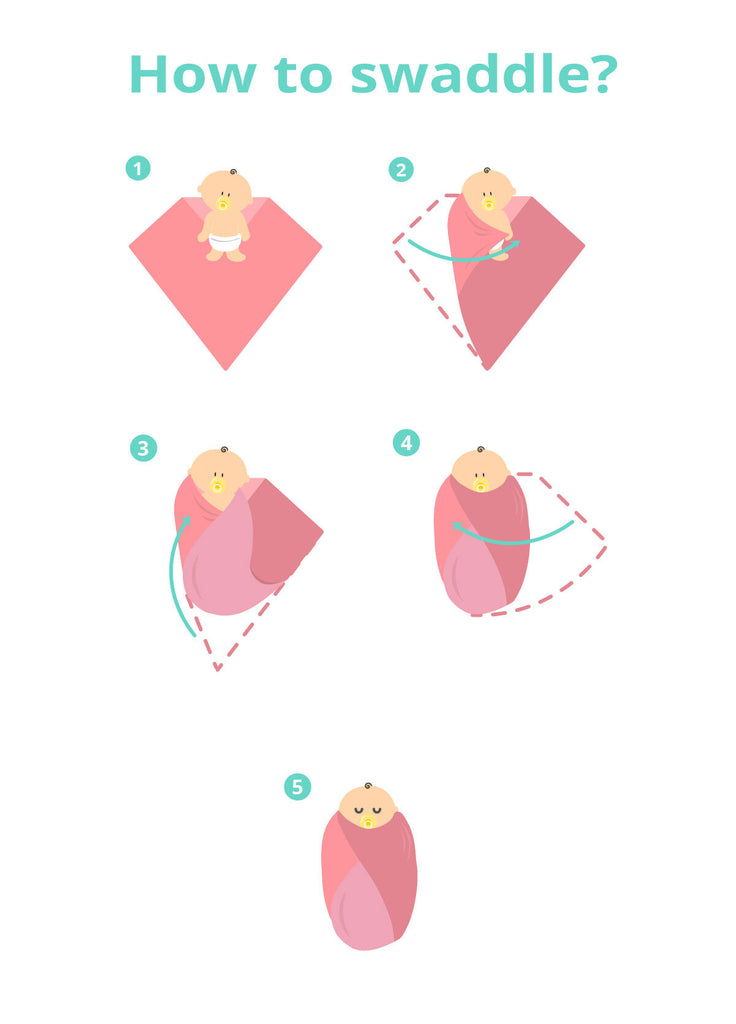The Art of Swaddling: A Guide for New Parent
What Does Swaddling Mean?
Swaddling is a popular method parents use to wrap their baby snugly during sleep. It dates back to ancient times when parents and caretakers recognized the benefits of swaddling and like most things that work, it’s here to stay. Swaddling your baby keeps them feeling safe and comfortable; as the wrapping imitates the womb and soothes them. This promotes a healthy night sleep and if they happen to stir, they can self-sooth back to sleep.

The method involves wrapping a baby in a light blanket that is folded at the top and wrapped around the baby's body up to the neck, with the hands folded and the blanket secured to itself. To allow for some movement and breathing, it is important that the swaddling is not done too tightly. Also keep in mind that this method is only recommended for newborns and babies up to 4 months, it is not recommended for babies who are able to roll on their tummy. Please consult a professional before you start practicing swaddling on your baby.
When it’s done correctly, it is a wonderful and safe way to soothe and comfort your infant during sleep. Here are a few tips and bits of useful information to help you get started on your swaddling journey.
5 Reasons to Swaddle
Swaddling your baby has so many positive benefits. Here are some of our favorites:
- SOOTHING It helps calm your baby when they’re upset or overwhelmed. The wrapping takes them right back to being in the womb and provides a secure and familiar feeling. The pressure from swaddling will also stimulate the baby's proprioceptive system, which begins to develop in utero and continues to do so especially in the first few months, it is responsible for sensing pressure and movement outside of the body.
- IMPROVED SLEEP The comfort created by wrapping your baby has been proven to reduce the startle reflex that many newborns get when falling asleep. This reflex can cause the baby to suddenly jerk its arms and legs, which can frighten and awaken from a sound sleep. If the baby's arms and legs are swaddled tightly, it can prevent the startle and having to start the bedtime process over again.
- LESS CRYING Because your baby will feel safer and more comfortable, swaddling will also reduce crying and sleep for longer periods of time. A snug and cozy swaddle will prevent them from becoming overstimulated or overwhelmed. Newborns are easily overstimulated, leading to fussiness and crying which can quickly escalate and can be hard to calm down, which can make a long evening for everyone involved.
- BODY TEMPURATURE REGULATION Swaddling can help regulate your baby's body temperature and keep them warm and comfortable in different ways:
- It helps prevent heat loss or being too warm. A newborn baby cannot regulate its body temperature as effectively as us adults can, so swaddling in a blanket can help keep them at a steady and comfortable temperature. This is especially important in colder environments or when the baby is not dressed for the weather.
- It maintains the child's body temperature during sleep. Swaddling keeps a consistent body temperature decreases the chances of the baby waking up.
In addition, it is important to monitor the baby's body temperature and, if necessary, adjust their clothing so that they feel comfortable and safe.
Overall, swaddling is an effective technique for keeping your baby calm, quiet, safe and just the right temperature. It is important to ensure that the baby is properly and securely swaddled to prevent any risks or injuries. It is also necessary to monitor their sleep, and if necessary adjust the swaddled blanket to make it safe and comfortable for them.
HOW TO SAFE SWADDLE
- Use an air cloth or blanket made of light, breathable fabric such as Pima Cotton or Muslin. Avoid blankets made of heavy or synthetic fabrics, which can cause overheating or skin irritation.
- Position the blanket correctly: Place the blanket so that it forms a diamond shape with one point at the top. Bend the top corner of the diamond to create a straight edge. Place the baby with their head on the flat edge and their arms on the side of their body.
- Make sure the wrap is not too tight and allows for proper movement and breathing. The blanket should be snug; you should be able to slide two fingers between the blanket and the baby's chest.
- Leave a place for hip movement at the bottom of the blanket so the baby can move their legs and hips. The baby's legs should bend and move freely with-in the wrapped blanket.
- Do not cover the baby's head or cover their face.
- Monitor the baby's temperature regularly so that they are not too hot. A good way to check is by feeling the back of their neck or belly, and keep the room at a temperature that your pediatrician recommends.
- Avoid swaddling babies that are able to roll over on their stomach by themselves, they are too old for this at this age.
- Stop swaddling when the baby starts to show signs of trying to get free. This usually happens at 2-3 months of age.
- Always put the baby to sleep on their back, especially when they are swaddled.
- You should always consult a healthcare professional before swaddling to make sure it is appropriate and safe for your baby.
Step by Step Guide for a Snug Swaddle:
Step 1: Start with a square blanket that you place on a flat surface in a diamond shape with one corner facing you.
Step 2: Take the top corner of the blanket and fold it down about 6 inches.
Step 3: Place the baby on their back on the blanket with their head above the folded corner and their arms by their body.
Step 4: Take the left corner of the blanket and push it under the baby's right arm and bring it over their chest. Make sure the blanket is snug but not too tight.
Step 5: Tuck the left corner of the blanket under their right side, making sure the left arm is by the body.
Step 6: Fold the bottom corner of the blanket up and tuck it under their chin.
Step 7: Take the right corner of the blanket and slide it under the baby's left arm and bring it over their chest.
Step 8: Tuck the right corner of the blanket under the baby's left side, making sure their right arm is against the body.
Step 9: Make sure the swaddle is snug, but not too tight. The snug wrap is to provide comfort and security but is not so tight that it restricts the baby's movement or breathing. You should be able to slide two fingers between the blanket and the baby's chest.

When to Stop Swaddling?
It is important to stop swaddling at the right time to ensure the safety and correct development of the baby’s growth.
You should stop swaddling when the baby is about 2-3 months old, the best indicator is when they start to show signs of rolling over. Additionally, as babies grow and develop, they may become more active and prefer more freedom of movement. Continuing to swaddle a baby who is trying to move can hinder their physical development and motor skills and create frustration when trying to move.
We encourage you to consult your pediatrician for advice based on your baby's individual needs and development, especially when it comes to swaddling and sleeping routines. They may also be able to suggest other alternative calming techniques to help your baby sleep.
You can click here to shop our swaddle and baby blankets.
Swaddling FAQ
Should a baby's legs be bent in a swaddle?
When swaddling, you should always allow the baby to move their legs with-in the swaddle. Since babies are born with their hip joints still developing, making sure their legs are in a natural position while swaddling is super important, however out of the swaddle it is recommended to bend and move their legs which promotes healthy hip development. If your baby's swaddle is too tight that can restrict the needed and wanted leg movement.
Is swaddling necessary?
Swaddling is not necessary for all babies, but since all babies and their needs are unique, what works for some may not work for others. Swaddling can be beneficial to many infants, especially newborns, as it offers a sense of security and comfort. It can improve your baby's sleep, help with startle reflex control and soothe them. However, you need to follow safe sleep guidelines if you decide to swaddle your baby. Last but not least, please consult your paediatrician before doing so and ask for personalized advice for your baby.

